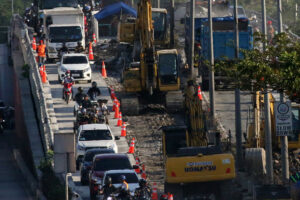By Karis Kasarinlan Paolo D. Mendoza
PHILIPPINE ECONOMIC GROWTH likely picked up in the second quarter as higher government spending may have offset the impact of El Niño on agriculture, analysts said.
A BusinessWorld poll of 19 economists and analysts conducted late last week yielded a median gross domestic product (GDP) year-on-year growth estimate of 6% for the April-to-June period.
If realized, this would be faster than the preliminary 5.7% growth in the first quarter and the 4.3% clip recorded in the second quarter of 2023.
This would also bring the first-half growth to an average of 5.9%, below the 6-7% growth target for the year.
The Philippine Statistics Authority will release the second-quarter GDP data on Thursday (Aug. 8).
“The main driver of growth was likely government spending. In contrast to last year’s underspending, the utilization rate of the 2024 budget has significantly improved,” HSBC ASEAN (Association of Southeast Asian Nations) economist Aris D. Dacanay said in an e-mail.
In an e-mail, Sarah Tan, an economist from Moody’s Analytics, said government spending and “robust” goods exports are expected to be the bright spots in the second quarter.
Data from the Bureau of the Treasury (BTr) showed that government spending rose by 14.6% year on year to P2.76 trillion in the second quarter.
Mr. Dacanay said the strong labor market may have also helped sustain household spending despite elevated inflation and high interest rates.
The country’s employment rate reached 95.9% in May, slightly higher than the 95.7% recorded a year ago. The unemployment rate also slipped to 4.1% in June from 4.3% in May 2023.
Victor A. Abola, an economist at the University of Asia and the Pacific, said high employment, “very elevated” government spending, and better-than-expected remittances have also contributed to faster growth.
Overseas remittances in the January-to-May period grew 3% to $13.37 billion from $12.98 billion a year ago.
EL NIñOMeanwhile, El Niño’s impact on agriculture and slower household consumption may have constrained growth in the second quarter, analysts said.
Bank of the Philippine Islands Lead Economist Emilio S. Neri, Jr. said El Niño was likely a drag on the economy, both demand and supply side, as early as the first quarter.
Ruben Carlo O. Asuncion, chief economist of Union Bank of the Philippines, Inc., said El Niño had a “scalding impact” on farm employment and rural incomes.
“Aside from the severe El Niño-related drought effects that cut down farm production, agricultural jobs and incomes, and contributed to higher food costs, the BSP (Bangko Sentral ng Pilipinas) sentiment that reeked of more pessimism among households and business respondents, likely translated to lackluster spending during the quarter,” he said in an e-mail.
Mr. Asuncion said “price-conscious” households may have postponed purchasing big-ticket consumer items until incomes fully recover.
Headline inflation eased to 3.7% year on year in June. For the first six months of 2024, headline inflation averaged 3.5%, slightly higher than the central bank’s 3.3% full-year forecast.
The BSP kept its key rate steady at 6.5% in June, the highest in over 17 years.
“Private consumption and investment will likely slow from the prior quarter as the high borrowing costs continue to weigh on their budgets and confidence,” Ms. Tan said.
For the rest of the year, analysts expect growth to continue as inflation eases.
“We are hopeful that slower inflation in [the second semester] will help boost consumer confidence further. Slower rice inflation should help free up some of the Filipino consumers’ budget to help boost demand for nonfood consumer items. We also expect midterm elections spending to pick up even faster in the second semester to boost public sector spending,” Mr. Neri said.
BSP Governor Eli M. Remolona, Jr. earlier said that he expects inflation to ease in the second semester with the implementation of lower tariffs on rice.
Last month, President Ferdinand R. Marcos, Jr. signed Executive Order No. 62 which slashed tariffs on rice imports to 15%, helping tame rice prices.
“We do expect year-on-year growth to ease in [the second semester] as favorable base effects ease. Nonetheless, we expect sequential growth to still be punchy, most especially when rice prices begin to drop, freeing up a big portion of household budgets and boosting private consumption,” Mr. Dacanay said.
However, Ms. Tan sees full-year economic growth to be below the government’s target of 6-7%.
“Across 2024, the Philippine economy is expected to grow 5.9%, outperforming many of its regional peers. An acceleration in exports from 2023 will bring this to fruition while private consumption will be the weakest link resulting in the economy missing the government’s growth target of 6-7% for the year. Still, a relatively tight labor market and a healthy inflow of remittances will cushion some of that pain,” she said.
